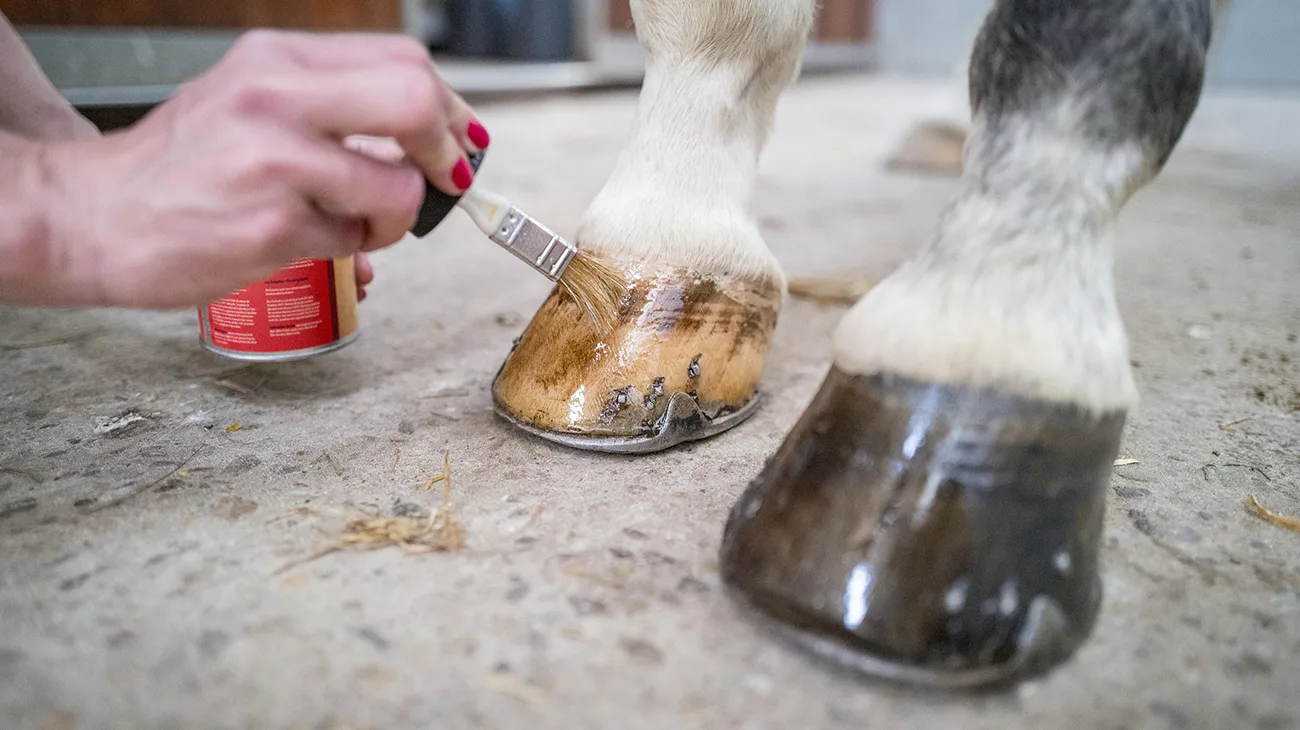Steven Kraus, BS, CJF, the head of farrier services and a lecturer in large animal surgery at Cornell University’s College of Veterinary Medicine (New York), thinks of horse care information spreading as if in a game of telephone. The original message, passed from person to person, becomes distorted, full of gaps and often downright silly.
“They change the message every time they relate it,” Kraus said of the way horse owners sometimes pass along crucial information.
Somewhere along the line, the facts get lost, and the myth lives on—as in the folk wisdom that white hooves are structurally weaker than dark hooves.
In Kraus’ work, it’s not uncommon for him to encounter myths that butt up against science. With the metal-hammering sounds of Cornell’s farrier school in the background, Kraus explains that—in spite of that morbid rhyme about feeding a white-hooved horse to the crows—light hooves are not weaker than dark hooves.

“The only difference between white hooves and dark or black hooves is pigment,” Kraus said. “The pigment has nothing to do with the structural integrity of the foot.”
The pigment-producing cells Kraus references are called melanocytes, and they’re often present on just the surface of hooves anyway.
Kraus, who’s taught farriery at Cornell for the last 13 years and just published a book, “Shoeing The Modern Horse,” thinks a lot about how to communicate the concept of hoof strength.
ADVERTISEMENT
“Hoof strength is almost like the difference between hardwood and softwood, when you think about it,” he said. “So hooves that are under stress, that don’t hold up well, are like a soft wood that is damaged easily and maybe even rotting a little bit because it’s attacked by microorganisms. Whereas a good solid foot is more like hardwood and not easily damaged or cracked.”
While there are many factors that contribute to a hoof ’s quality, color isn’t one of them. Strength is better predicted by nutrition, environment and genetics. For example, there’s another bit of common wisdom that Thoroughbreds often have bad feet—and that idea is one this farrier won’t dispute. He offers his own Thoroughbred mare’s bad feet as an example of how genetics can necessitate more careful hoof management. Although Kraus is an expert farrier, he still has to contend with his horse’s genetic disadvantages.
“If a horse is going to have genetically strong hooves, that’s a good start. If it has genetically weak hooves, then you’re starting with a deficit.”
Steven Kraus, BS, CJF
“Thoroughbreds tend to have not as good a hoof as some other breeds, right?” Kraus said. “Thoroughbreds are bred to be lighter. They have lighter bones; they have lighter skin. The hooves and skin are all part of the same system, so thinner soles, thinner walls on the hooves—there’s less material there than some cross-bred horse.”
But hoof color doesn’t contribute to its structure so, aside from personal aesthetics, it shouldn’t contribute to the evaluation of an animal.
“It’s all in the genetics of the individuals,” Kraus said. “If a horse is going to have genetically strong hooves, that’s a good start. If it has genetically weak hooves, then you’re starting with a deficit.”
Farriers and veterinarians often have to navigate the anecdotal evidence of horse owners who swear that, whatever the science says, their horse comes up lame on their leg with the white hoof alone, or that only their light-hoofed horse consistently throws shoes.
ADVERTISEMENT
In these instances, it’s easier to make the obvious observation, like color, than it is to uncover the more nuanced reason a horse might be weaker on one side, or why a horse might not be absorbing nutrients as effectively as his pasturemate on a similar diet. Anecdotes distract from the scientific studies where results can be recreated in experiment after experiment.
“When you’re teaching this stuff, I want stuff that’s repeatable,” Kraus said. “I don’t want people to think I perform magic. There is no magic here; this is common sense.”
To break the game of horse-hoof telephone, horse owners have to consider complicating factors with a scientific lens: variables like conformation or exposure to moisture. Even the way horses move impacts hoof health: The way horses load weight on their hooves determines how blood, and therefore nutrients, is distributed to the hoof wall. To get to the true cause of an issue, a horse owner needs to lean on the science—and to stay open minded when that science conflicts with traditional wisdom.
“There’s a lot of moving parts here,” Kraus said. “I wish we could just wave a magic wand and make every horse have good feet. But it’s a battle uphill.”
This article originally appeared in the Oct. 30-Nov. 20, 2023, issue of The Chronicle of the Horse. You can subscribe and get online access to a digital version and then enjoy a year of The Chronicle of the Horse and our lifestyle publication, Untacked. If you’re just following COTH online, you’re missing so much great unique content. Each print issue of the Chronicle is full of in-depth competition news, fascinating features, probing looks at issues within the sports of hunter/jumper, eventing and dressage, and stunning photography.














